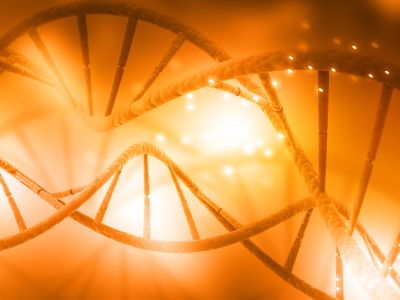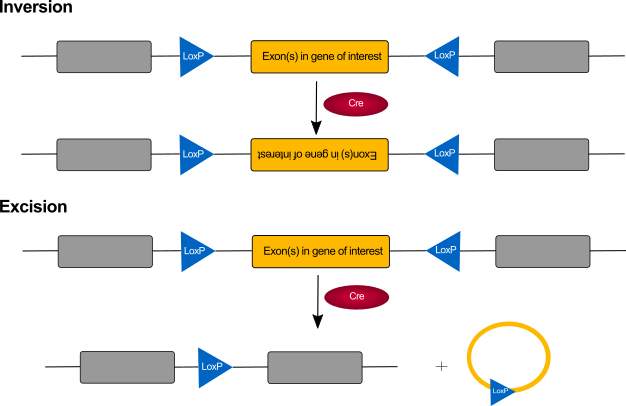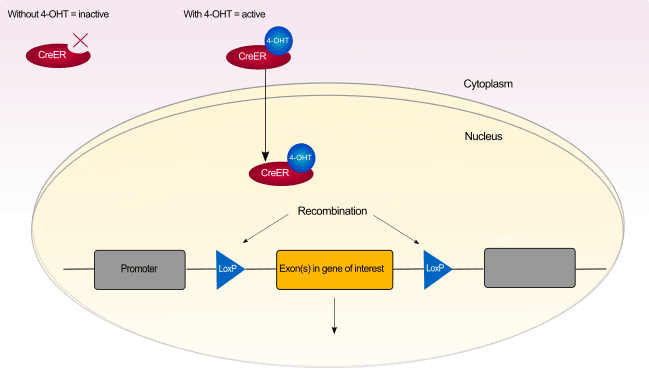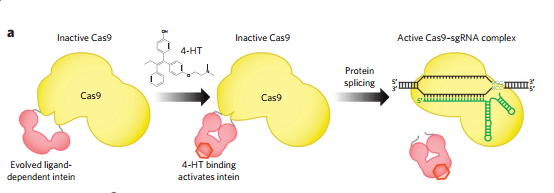Inducible CreER and CRISPR/Cas9 genome engineering techniques using small molecules

Genome engineering involves making targeted modifications to the genome. It has facilitated functional characterization of genes and the development and study of disease models [1], [2]. Recent advances in genome engineering technologies have sparked a new revolution in biological research and offer great potential for applications in biotechnology, life science and medicine [3].
Over the past 30 years, a variety of techniques have been developed which modify the genome. For example, site-specific recombination systems such as Cre-LoxP and Flp-FRT and more recently, targeted genome editing techniques based on programmable nucleases such as the revolutionary CRISPR/Cas9 system have been developed [3], [4].
Small molecule chemical compounds play a crucial role in genome engineering and are essential to a variety of genome editing techniques including the inducible CreER system and more recently, have shown exciting new applications in the CRISPR/Cas9 system.
Genome manipulation using site specific recombinases

Figure 1: Cre-mediated gene modification:
Cre catalyzes recombination between two loxP sites: Inversion - if the LoxP sites are in opposite orientations inversion of the flanked segment occurs. Excision - If the sites face the same direction, the DNA segment flanked by the LoxP sites is excised
Genome modification can be achieved by using site-specific recombination systems which utilise recombinases. Two commonly used techniques are the Flp-FRT and Cre-LoxP systems which can be used to develop conditional knockout mice [15].
The Cre-LoxP system utilises the Cre recombinase which is derived from the P1 bacteriophage [6], [7]. Cre recognizes two specific 34-bp sites called LoxP which are found on an essential exon of a gene of interest.
Cre catalyses recombination between these two LoxP sites to excise or invert the DNA segments flanked by these LoxP sites. [8] (See Fig 1). The Cre-LoxP system thus provides the ability to knock out exon(s) in the gene of interest.
Ligand inducible Cre recombinases (CreER) for inducible gene manipulation
The use of small molecules became essential to the Cre-LoxP system following subsequent modifications to create an inducible Cre-LoxP system which uses engineered Cre recombinases (termed CreER) to control Cre activity.
A variety of these engineered CreER variants have been developed (E.g. CreERT2) and consist of Cre fused to a mutated ligand-binding domain of the estrogen receptor. This allows the binding of estrogen ligands such as tamoxifen and 4-hydroxytamoxifen (4-OHT/ 4-HT) [5].
CreERs remain inactive until being selectively activated by 4-OHT which is a synthetic estrogen receptor ligand [6], [10]. Inactive CreER recombinases remain in the cytoplasm however, following the introduction of 4-OHT, CreER translocates into the nucleus and induces the targeted mutation to exon(s) in a gene of interest [5]. (See figure 2).

Figure 2 – 4-OHT inducible CreER activity for gene manipulation: following activation with 4-OHT, CreER translocates from the cytoplasm to the nuclease and induces target gene mutations.
Importantly, inducible CreERs allow the external, temporal control of Cre activity in vivo [4], [6] and due to its critical role in this process, 4-OHT has become the de facto standard for inducing CreER based genome manipulation in vivo.
Targeted genome editing using site-specific nucleases
In addition to using site specific recombinases, targeted genome editing which uses site-specific nucleases has emerged as a promising technology to engineer precise genetic modifications in the genome [1].
Targeted genome editing can be used to study gene function or for modifying the genome by correcting defective genes or by introducing genes [13].
Various techniques have been developed including:
• Zinc-finger nucleases (ZFNs),
• Targetrons,
• Meganucleases (MNs),
• Transcription activator-like nucleases (TALENs)
• Clustered regularly interspaced short palindromic repeats and the Cas9 endonuclease (CRISPR/Cas9)
These techniques edit the genome by using programmable nucleases to introduce site-specific double-stranded breaks (DSBs) in DNA. These DSBs are then repaired by the host cells using the non-homologous end joining repair system (NHEJ) or the homologous recombination-based double-strand break repair pathway (HDR) [14], [3]. (See Figure 3).
DSBs in the genome can be used to cause functional knockout of a targeted gene or can knock in a DNA sequence at a specific locus in the genome.

Figure 3 – Site- specific double stranded breaks made by programmable nucleases are repaired by host cells using the NHEJ system or the HDR system to allow genetic deletions, insertions and modifications.
CRISPR/Cas9
Whereas ZFNs and TALENs recognize specific DNA sequences via protein-DNA interactions, CRISPR/Cas9 is an RNA-guided system. The Cas9 endonuclease is directed to specific DNA sequences by a simple to engineer, 20-nt single guided RNA (sgRNA) to generate DSBs at virtually any targeted DNA locus [14], [16].
The CRISPR/Cas9 consequently provides a simple, efficient and robust method to directly mutate the genome through targeted gene deletions [15], [14].
Small molecules enhance CRISPR-mediated efficiency
CRISPR/Cas9 is now an extremely powerful and robust tool for genome editing, however limitations in its applications still exist. For example, the CRISPR/Cas9 system is limited by the relatively low efficiency of the HDR pathway compared with the higher efficiency of the NHEJ pathway and can therefore be inefficient for precise genome sequence editing [20] [21].
Small molecule chemicals are potentially a simple and effective strategy which can help to enhance precise genome engineering. Indeed, several small molecules have been shown to interact with the HDR and NHEJ pathways and have been shown to enhance both CRISPR-mediated HDR and NHEJ mediated mutations [20].
- 4-hydroxytamoxifen – activates mutated Cas9s to increase CRISPR-mediated specificity and efficiency.
- RS-1 - improves efficiency of HDR and enhances Cas9-mediated knock in efficiency
- Azidothymidine - decreases CRISPR-mediated HDR and enhances gene knockout efficiency
- Nocodazole - increases HDR efficiency and increase Cas9-mediated gene editing frequencies
- SCR7 – enhances HDR efficiency
- Brefeldin A – enhances CRISPR-mediated HDR efficiency
- L-755,507 – enhances CRISPR-mediated HDR efficiency
- KU 0060648 – increases rate of HDR and reduces NHEJ frequency
- NU 7441 – increases rate of HDR and reduces NHEJ frequency
Chemical inducible CRISPR-Cas9:– small molecule control of Cas9 activity
Inducibility of genome editing systems has proven to be extremely important and efforts continue to develop inducible CRISPR/Cas9 systems to try to provide high resolution temporal control of Cas9. Due to imperfect DNA cleavage specificity of Cas9, efforts are also being made to improve editing specificity and efficiency of the CRISPR/Cas9 system [16].
One approach to address these issues involves the development of chemical-inducible Cas9 variants in which Cas9 variants have been engineered so that their activity can be controlled using a specific chemical. In addition to Rapamycin and doxycycline-inducible Cas9 systems (iCRISPR) [19] [18], Cas9 has been fused with the ligand binding domains of the estrogen receptor allowing selective binding of 4-OHT [17], [22].
In 2016, Liu et al reported the development of the Cas9 variant “iCas” in which Cas9 was fused with the ligand-binding domain of the estrogen receptor (ERT2) to create a Cas9 variant whose nuclease activity is tightly controlled by 4-OHT [17].

Figure 4 (Image from Liu et al, 2016) - an evolved ligand-dependent intein was inserted to created a Cas9 variant which can be selectively activated by 4-OHT to increase Cas9 specificity
Once activated by 4-OHT, iCas allows the repeatable, switching on- and off Cas9 activity in human cells and has high editing efficiency at multiple loci whilst showing low nuclease activity when not bound with 4-OHT. This chemical-inducible CRISPR/Cas9 system therefore allows rapid and reversible control of genome-editing function.
To increase editing specificity of Cas9, Davis et al evolved an intein which undergoes protein splicing only in the presence of 4-OHT. This evolved, ligand-dependent intein was inserted at specific positions in Cas9 to create a Cas9 variant which can selectively be activated by 4-OHT (See Figure 4).
Once activated by 4-OHT, this Cas9 variant modified target genomic sites in human cells with >25-fold higher specificity than wild-type Cas9 [16].
Efforts continue to use small molecules to improve control of Cas9 and improve the CRISPR/Cas9 system, for example Maji et al recently utilised small-molecule-regulated protein degron domains with Cas9 to create a system shown to permit user-defined turn-on and turn-off of endogenous gene transcription. The group aim to establish Cas9 systems with multidimensional control of genome editing and transcription activities [23].
Conclusion
Small molecules currently play a crucial role in applying inducible control and improvement of genome editing techniques such as CRISPR/Cas9. As the field continues to grow and develop, small molecules will continue to be essential to these techniques.
References
- Ma D et al (2015) Genome Editing and Its Applications in Model Organisms. Genomics Proteomics Bioinformatics 13(6) 336-44. Pubmed ID:26762955
- Eid A et al (2016) Genome editing: the road of CRISPR/Cas9 from bench to clinic. Exp Mol Med 48(10) e265. Pubmed ID:27741224
- Hsu PD et al (2014) Development and applications of CRISPR-Cas9 for genome engineering. Cell 157(6) 1262-78. Pubmed ID:24906146
- Rocha-Martins M et al (2015) From Gene Targeting to Genome Editing: Transgenic animals applications and beyond. An Acad Bras Cienc 87(2 Suppl) 1323-48. Pubmed ID:26397828
- Feil S et al (2009) Inducible Cre mice. Methods Mol Biol 530 343-63. Pubmed ID:19266339
- Fuhrmann-Benzakein E et al (2000) Inducible and irreversible control of gene expression using a single transgene. Nucleic Acids Res 28(23) E99. Pubmed ID:11095695
- Feil R et al (1997) Regulation of Cre recombinase activity by mutated estrogen receptor ligand-binding domains. Biochem Biophys Res Commun 237(3) 752-7. Pubmed ID:9299439
- Reinert RB et al (2012) Tamoxifen-Induced Cre-loxP Recombination Is Prolonged in Pancreatic Islets of Adult Mice. PLoS One 7(3) e33529. Pubmed ID:22470452
- Maizels N (2013) Genome engineering with Cre-loxP. J Immunol 191(1) 5-6. Pubmed ID:23794700
- Deng, CH (2012) The Use of Cre–loxP Technology and Inducible Systems to Generate Mouse Models of Cancer. Genetically Engineered Mice for Cancer Research. 17-36
- Chen X et al (2016) Targeted genome engineering in Caenorhabditis elegans. Cell Biosci 6 60 Pubmed ID:27980716
- Hayashi S et al (2002) Efficient recombination in diverse tissues by a tamoxifen-inducible form of Cre: a tool for temporally regulated gene activation/inactivation in the mouse. Dev Biol 244(2) 305-18. Pubmed ID:11944939
- Guha TK et al (2017) Programmable Genome Editing Tools and their Regulation for Efficient Genome Engineering. Comput Struct Biotechnol J 15 146-160. Pubmed ID:28179977
- Senturk S et al (2017) Rapid and tunable method to temporally control gene editing based on conditional Cas9 stabilization. Nat Commun 8 14370 Pubmed ID:28224990
- Cao J et al (2016) An easy and efficient inducible CRISPR/Cas9 platform with improved specificity for multiple gene targeting. Nucleic Acids Res 44(19) e149. Pubmed ID:27458201
- Davis KM et al (2015) Small molecule-triggered Cas9 protein with improved genome-editing specificity. Nat Chem Biol 11(5) 316-8. Pubmed ID:25848930
- Liu KI et al (2016) A chemical-inducible CRISPR-Cas9 system for rapid control of genome editing. Nat Chem Biol 12(11) 980-987. Pubmed ID:27618190
- de Solis CA et al (2016) The Development of a Viral Mediated CRISPR/Cas9 System with Doxycycline Dependent gRNA Expression for Inducible In vitro and In vivo Genome Editing. Front Mol Neurosci 9 70 Pubmed ID:27587996
- Zetsche B et al (2015) A split-Cas9 architecture for inducible genome editing and transcription modulation. Nat Biotechnol 33(2) 139-42. Pubmed ID:25643054
- Yu C et al (2015) Small molecules enhance CRISPR genome editing in pluripotent stem cells. Cell Stem Cell 16(2) 142-7. Pubmed ID:25658371
- Chu VT et al (2015) Increasing the efficiency of homology-directed repair for CRISPR-Cas9-induced precise gene editing in mammalian cells. Nat Biotechnol 33(5) 543-8. Pubmed ID:25803306
- Nguyen DP et al (2016) Ligand-binding domains of nuclear receptors facilitate tight control of split CRISPR activity. Nat Commun 7 12009 Pubmed ID:27363581
- Maji et al (2017) Multidimensional chemical control of CRISPR-Cas9. Nat Chem Biol Pubmed ID:27820801




